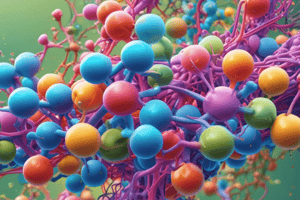Podcast
Questions and Answers
What is the basis for the classification of enzymes in the EC system?
What is the basis for the classification of enzymes in the EC system?
- The pH optimum of the enzyme
- The type of substrate they act on
- The location of the enzyme in the cell
- The nature of the chemical reactions they catalyze (correct)
Which of the following is an example of an enzyme name based on the nature of the reaction?
Which of the following is an example of an enzyme name based on the nature of the reaction?
- Urease
- Trypsin
- Oxidase (correct)
- Pepsin
What is the purpose of the EC classification system?
What is the purpose of the EC classification system?
- To classify enzymes based on their reaction mechanisms
- To standardize enzyme names
- To distinguish between different enzyme types
- To provide a universal system for enzyme classification and naming (correct)
What is the first number in an EC classification number?
What is the first number in an EC classification number?
What is the function of oxidoreductases?
What is the function of oxidoreductases?
What is the basis for naming enzymes in the IUB system?
What is the basis for naming enzymes in the IUB system?
What is the common name for oxidoreductases wherever possible?
What is the common name for oxidoreductases wherever possible?
What is the prefix for EC classification numbers?
What is the prefix for EC classification numbers?
What is the primary function of transferases?
What is the primary function of transferases?
What is the naming convention for transferases?
What is the naming convention for transferases?
What is the classification number for hydrolases?
What is the classification number for hydrolases?
What is unique about the naming convention of hydrolases?
What is unique about the naming convention of hydrolases?
What is the primary function of lyases?
What is the primary function of lyases?
What is the naming convention for lyases?
What is the naming convention for lyases?
What is the term used for lyases that eliminate water?
What is the term used for lyases that eliminate water?
What is the term used in the name of lyases when the reverse reaction is more important?
What is the term used in the name of lyases when the reverse reaction is more important?
What type of reaction do Oxidoreductases catalyze?
What type of reaction do Oxidoreductases catalyze?
Which enzyme class is responsible for the formation of C—C, C—S, C—O, and C—N bonds?
Which enzyme class is responsible for the formation of C—C, C—S, C—O, and C—N bonds?
What is the name of the enzyme class that catalyzes the movement of ions or molecules across membranes or their separation within membranes?
What is the name of the enzyme class that catalyzes the movement of ions or molecules across membranes or their separation within membranes?
What is the typical naming convention for enzymes that catalyze the joining of two molecules with concomitant hydrolysis of the diphosphate bond in ATP or a similar triphosphate?
What is the typical naming convention for enzymes that catalyze the joining of two molecules with concomitant hydrolysis of the diphosphate bond in ATP or a similar triphosphate?
Which enzyme class catalyzes the transfer of groups within molecules to yield isomeric forms?
Which enzyme class catalyzes the transfer of groups within molecules to yield isomeric forms?
What is the purpose of the EC classification system?
What is the purpose of the EC classification system?
What type of reaction do Hydrolases catalyze?
What type of reaction do Hydrolases catalyze?
Which enzyme class is responsible for the transfer of groups from one molecule to another?
Which enzyme class is responsible for the transfer of groups from one molecule to another?
Flashcards are hidden until you start studying
Study Notes
Enzyme Nomenclature
- Enzyme nomenclature in the early 20th century lacked consistency, leading to inconsistencies in naming conventions.
Inconsistencies in Nomenclature
- Four systems of nomenclature were used, including:
- Combining "ase" with the substrate name (e.g., amylase, urease)
- Combining "ase" with the end product name (e.g., alcoholase, glucose)
- Based on the nature of the reaction (e.g., oxidase, reductase, invertase)
- Using terms with no connection to the process (e.g., zymase, pepsin, trypsin)
EC Scheme for Classification
- Enzymes are classified and named based on the chemical reactions they catalyze.
- The EC scheme uses a four-part classification number (e.g., aconitate hydratase EC 4.2.1.3).
- The four parts of the classification number indicate:
- Class (e.g., oxidoreductases)
- Subclass
- Sub-subclass
- Serial number in sub-subclass
Enzyme Classes
-
There are six major classes of enzymatic reactions:
EC 1: Oxidoreductases
- Catalyze oxido-reductions
- Substrate oxidized is regarded as a hydrogen or electron donor
- Classification based on 'donor:acceptor oxidoreductase'
EC 2: Transferases
- Catalyze group transfer reactions
- Classification based on 'donor:acceptor grouptransferase'
EC 3: Hydrolases
- Catalyze hydrolysis reactions
- Classification based on 'substrate hydrolase'
EC 4: Lyases
- Catalyze cleavage of C-C, C-O, C-N, and other bonds
- Classification based on 'substrate group-lyase'
EC 5: Isomerases
- Catalyze changes within a single molecule
EC 6: Ligases
- Catalyze joining of two molecules with concomitant hydrolysis of ATP or similar triphosphate
EC 7: Translocases
- Catalyze movement of ions or molecules across membranes or their separation within membranes
Studying That Suits You
Use AI to generate personalized quizzes and flashcards to suit your learning preferences.




